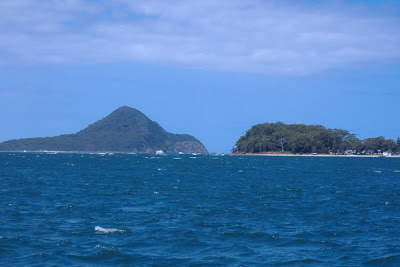 I started the morning at 6:30am and rode straight to Berowa train station. I would have caught the train from Straithfield, however there was trackwork on the Newcastle line and a bike unfriendly bus service running between Straithfield and Berowa.
I started the morning at 6:30am and rode straight to Berowa train station. I would have caught the train from Straithfield, however there was trackwork on the Newcastle line and a bike unfriendly bus service running between Straithfield and Berowa. I arrived at Newcastle at around 11:30am and in no time I was on the ferry to Stockton. It only cost $1 to catch the ferry...
I arrived at Newcastle at around 11:30am and in no time I was on the ferry to Stockton. It only cost $1 to catch the ferry... ... and they great bike racks. From Stockton, I rode 50km along Nelson Bay Road to Nelson Bay. I was a bit anxious as to what the road would be like but it had an excellent shoulder. There was a lot of holiday traffic but no dramas.
... and they great bike racks. From Stockton, I rode 50km along Nelson Bay Road to Nelson Bay. I was a bit anxious as to what the road would be like but it had an excellent shoulder. There was a lot of holiday traffic but no dramas. I arrived at Nelson Bay at around 1:30pm. I had an hour break with enough time to grab some fish and chips before catching the 2:30pm ferry to Tea Gardens.
I arrived at Nelson Bay at around 1:30pm. I had an hour break with enough time to grab some fish and chips before catching the 2:30pm ferry to Tea Gardens.  On the ferry, my bike was just tied onto the roof of the old boat. It was a bit more expensive costing $15, but was much more scenic.
On the ferry, my bike was just tied onto the roof of the old boat. It was a bit more expensive costing $15, but was much more scenic.  It took just on an hour to get across Post Stephens. There area is renown for Dolphin watching but I was unlucky to see any on the day.
It took just on an hour to get across Post Stephens. There area is renown for Dolphin watching but I was unlucky to see any on the day. From Tea Gardens its a short ride to Myall Lakes National Park. On the map, there was a more direct walking track heading straight along the coast to Seal Rocks, but as I was on my road bike I took the more scenic route around the lakes.
From Tea Gardens its a short ride to Myall Lakes National Park. On the map, there was a more direct walking track heading straight along the coast to Seal Rocks, but as I was on my road bike I took the more scenic route around the lakes. Another 30km along, I arrived at Bombah Point where I had to catch my third ferry of the day.
Another 30km along, I arrived at Bombah Point where I had to catch my third ferry of the day. From there, it was another 15km along a dirt road to the small highway town of Bulahdelah.
From there, it was another 15km along a dirt road to the small highway town of Bulahdelah. At Bulahdelah, I was back on the Pacific Highway for a couple of kilometers then I took the Lakes Way Rd turn off to Seal Rocks. I misjudged how long this part of the ride would take me. It was another 40km to Seal Rocks with a few steep hills to keep me awake.
At Bulahdelah, I was back on the Pacific Highway for a couple of kilometers then I took the Lakes Way Rd turn off to Seal Rocks. I misjudged how long this part of the ride would take me. It was another 40km to Seal Rocks with a few steep hills to keep me awake. I eventually got to Seal Rocks at 7pm. The town is amazingly quiet with only one cafe and a post office . I found the campsite around 7:30pm and was pleased to arrive as dinner was being made.
I eventually got to Seal Rocks at 7pm. The town is amazingly quiet with only one cafe and a post office . I found the campsite around 7:30pm and was pleased to arrive as dinner was being made.I think I've got the touring bug.









































